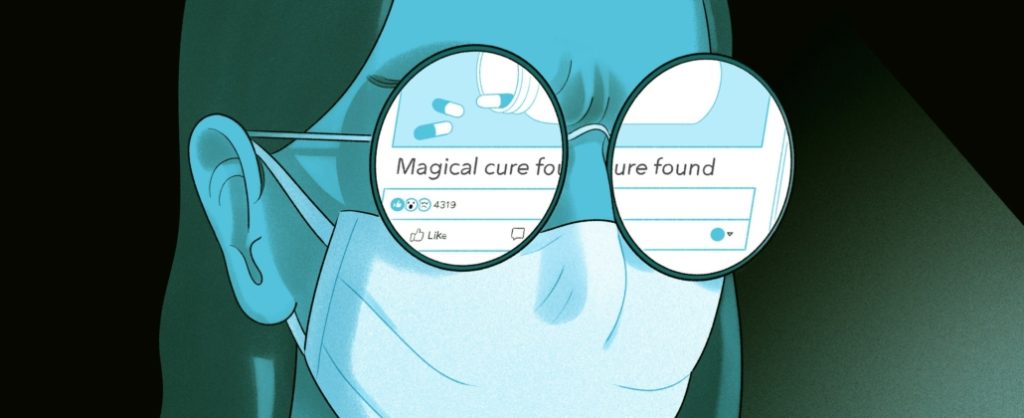Black is white.
This was the key idea behind George Orwell’s 1984, the book that re-gained its popularity in 2020 and became one of the references for setting up conspiracy theories during the pandemic. A series of disinformation and conspiracy theories, ranging from the assumption that the new 5G wireless broadband caused or spread the virus to an assumption that the virus is created to be a biological weapon, but the winner would be a theory that the pandemic is a cover for a plan to implant trackable microchips inside vaccines. With that, the concept of privacy is questioned as the states started employing modern technology to keep track of the virus outbreak cases, as well as keep watch on our behavior. In this way, fictive, dystopian scenarios seemed to depict some points of our current reality and made it quite easy for people to relate to the Big brother society.
Also, let us remind ourselves of The Simpsons show and how ‘’they’ve done it again’’ with predicting the future by giving us episodes that somewhat follow the line of today’s events. Just by one Google search, you can find titles such as ‘The Simpsons tried to warn us’ and ‘The Simpsons accurately predicted the future’. How about the 2021 doomsday following the US elections in The Simpsons’ 31st Halloween special episode Treehouse of Horror XXXI? We have all seen the storming of the Capitol on January 6th and how this event resembled the one in this episode. Seems pretty disturbing, doesn’t it?
Naturally, the multitude of different theories produces a divide in beliefs. We are all exposed to renewable sources of information, scrolling through pictures and news, letting the algorithms guide our clicks and lead us to the story we should believe in. But do we really believe them? How do we know what is the actual truth?
To begin with, a term conspiracy theory has a negative connotation, immediately implying that it provides information based on insufficient evidence. Simply put, it is an explanation to a situation relying on the position of power of certain individuals or groups, all with a political motive. These theories come in place where facts seem to fail to explain an ongoing situation and all logic leaves the door. However, the way theories fill in on these gaps, as well as the time they are being produced in and sent out, makes them convincing. What one must understand is that nothing is as it seems at first and all facts must be thoroughly checked.
But, in times like today, this can be a very challenging task as news spread quickly and modern technologies are amplifying biases in harmful ways. Research shows that the spread of content from low-credibility sources is far greater than the ones of a more credible nature, due to the linkage of social media bots. Bot strategy implies multitude of post shares to make certain news go ‘viral’. The higher the number of bots around a specific post, the higher the likelihood of algorithm suggesting that post. This further indicates that the spread of digital misinformation is intentional. Furthermore, human interaction online is what often boosts the clicks of a specific link, as they are more likely to trust their friends online and want to follow up on their activity, thus reading the shared content. In cases like these, a fact-checking system is what rarely comes to mind. In addition to that, one could discuss the multitasking method of today’s digital generation and the need to rapidly go through the content, forming an illusion that one saves up time. This way enables for unverified content to come through and one comprehends only the instantly generated content. But what can be done about it?
There are some discussed options. First, restricting social media is the option that many associate with restricting the freedom of speech. Yet, filtering online content with warning labels is what is ought to detect hate speech and disinformation, preventing the spread of harmful content. Also, the users generating the content should be checked if eligible to publish certain forms of information. In more ways than one, often the name behind a certain message is what makes it relevant. Thus, seeing warnings below may trigger further questioning of the information. A step even further would be making it more difficult to create and share low-quality information online by making users pay for the content they share or follow. This method may bring back the value to the information and provide users with verified information sources. Also, one of the options would include restricting our own access to low quality content and selecting what we want to be exposed to. Grasping the quality and sources of the content we are consuming is one step further towards detecting conspiracy theories, and yet another would be following on the work of experts that expose them for what they are with facts and relevant data.
Comparing our lives to the 1984 dystopian society or Springfield’s animated neighborhood excludes all reasoning that is supposed to link these to the notion of ‘fiction’. Yes, some of the events presented in the plots incredibly resemble the situations from our daily lives, but only once taken out of the context. Many shows can do so, as they are molded by the human mind based on the things people have seen or imagined. In a world with information overload, fact-checking system fails to emerge as the mandatory mechanism in online activities. Therefore, it is crucial for us to push for digital literacy and critical thinking to feed our overwhelmed minds. Only then will we be able to process data and analyze information in a way that contributes to our knowledge and wellbeing. Conspiracy theories have proven to disrupt our perception of reality, disabling clear comprehension of the world around us and the least it takes is to step back to realize the absurdity of it all.








